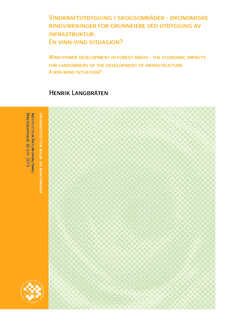| dc.description.abstract | Gjennom fornybardirektivet og den felles elsertifikatordningen med Sverige, er
forutsetningene for satsingen på ny fornybar energi satt frem mot 2020. Norge har et mål om 13,2 TWh ny fornybar energi. En stor andel av dette er antatt å komme fra vindkraft. Vindkraften er fra tidligere mest knyttet til kystområdene i Norge, men i den senere tid har også skogsområder i innlandet kommet i fokus for utbyggerselskapene. Dette bidrar med nye
elementer, da man ser på effekter av infrastrukturen som bygges i forbindelse med vindkraftutbygginger.
Denne oppgavens formål har vært å se på hvilke økonomiske ringvirkninger en
vindkraftutbygging kan ha for grunneieren innenfor planområdet for vindkraft i innlandet. For å belyse dette har de blitt sett på to ulike eksempelstudier på til sammen tre planområder.
Songkjølen og Engerfjellet begge i Nord-Odal kommune, og Raskiftet i Trysil og Åmot
kommune. For disse områdene har det blitt utført en analyse av verdien av de tapte arealene, samt en lønnsomhetsberegning av de nye internveiene som kan brukes til skogsdriften i etterkant av utbyggingen.
Analysene viser at henholdsvis 3 %, 4 % og 4,3 % av det totale arealet til planområdet blir båndlagt av infrastrukturen i forbindelse med vindkraftutbyggingen. Denne oppgaven har konkludert med at verditap på disse områdene på 891 kr, 1329 kr og 721 kr/ dekar som blir direkte berørt av utbyggingen. Verdien av områdene varier med andelen produktiv skog.
Treslag og bonitet ble også funnet til å være viktige faktorer for verdien av skogsområdene. I lønnsomhetsanalysen av de nye veiene ble det funnet at i alle områdene vil veien bidra til
økt lønnsomhet gjennom kortere driftsveilengder. Lønnsomheten av de nye internveiene ligger i området 93 – 973 kroner/ dekar berørt areal, som også kan uttrykkes som 13,1 til
136,1 kr/m3. Hvor stor lønnsomheten av de nye veiene er varier stort med arealet av tidligere null-områder. For Songkjølen ble det konstatert at lønnsomheten er høyere enn verditapet selv for det laveste scenarioet for lønnsomheten. For Engerfjellet og Raskiftet er lønnsomheten
mer enn verditapet for de to høyeste scenariene. The Renewable Energy Directive and the common certificate scheme with Sweden sets the conditions for investment in the renewable energy sector in Norway towards 2020. Norway has a target of total 13.2 TWh of new renewable energy. A large proportion of this development is expected to be in wind power. Wind power was previously mostly planned in
coastal areas of Norway, but recently also the inland and the forest areas of Norway have become focus areas. In the forest areas the effects of the infrastructure being built in the wind
power developments can be different from the coastal areas.
The purpose of this thesis is to examine the economic impacts that a wind development may
have for landowners within the planning area. To illustrate this, it has been looked at two different case studies, with total three planning areas. Songkjølen and Engerfjellet, both in Nord-Odal municipality, and Raskiftet in Trysil- and Åmot municipality. In these areas the value of the lost forest areas has been estimated, as well as a profitability analysis of the new
roads, which can be used for forestry operations in the future. The analysis has shown that respectively 3%, 4% and 4.3% of the total area of the planning
areas are lost to the infrastructure in connection with the wind power development. This study has concluded that the value of these areas is NOK 891, 1329 and 721 per daa. The value of
these areas varies with the proportion of productive land. Tree species and the site quality were also found to be important factors in the value of the forest areas.
In the profitability analysis of the new roads, it was found that the roads will contribute to increased profitability in all areas due to shorter handling distances. The profitability of the new road system will be in the range from NOK 13.1 to 136.1/m3, which also can be
expressed as NOK 93-973/daa. The number of previous zero-areas was a major factor in the road profitability analysis, and explains the wide range of the profitability. In Songkjølen it was found that the profitability will be higher than the value of the lost areas, even for the lowest profitability scenario. For Engerfjellet and Raskiftet the profitability is higher than the
value loss, for the two highest profitability scenarios. | no_NO |
